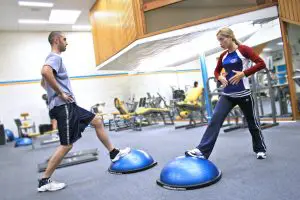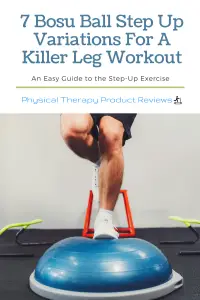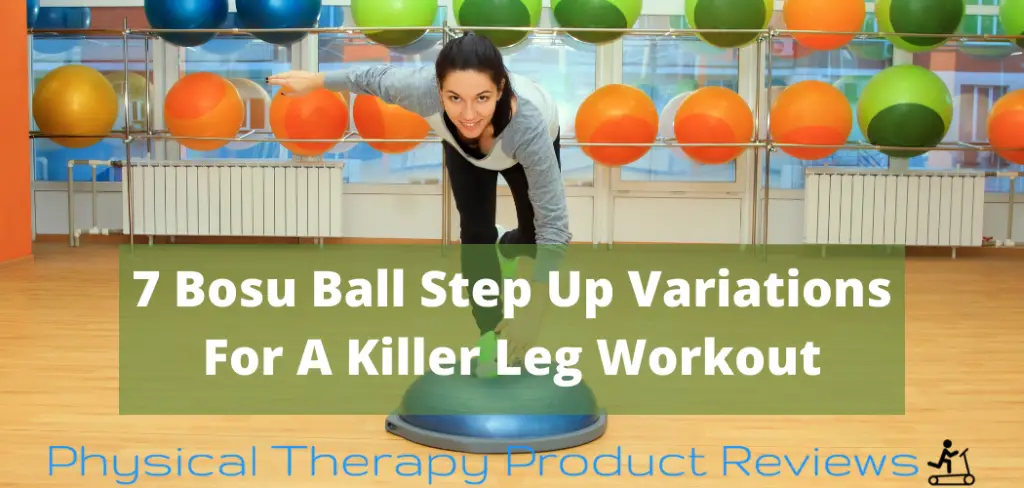A Bosu ball is an excellent addition to any home gym to increase core strength and balance. If you want a killer leg workout, the Bosu ball provides the perfect variance of exercises to achieve the look you want.
The versatility of being able to use both sides of the Bosu ball allows it offers a multitude of exercise options. As Physical Therapists, we love the combination of balance and strength that each Bosu exercise presents.
We’ll share our 7 favorite Bosu ball step-up variations for a killer leg workout. Enjoy a step-by-step guide as well as the answers to an array of popular FAQs.
What are Bosu Ball Step Ups?
A Bosu Ball step up is an excellent exercise for anyone who wants to work on core strength and balance.
Here is how to do the basics of a step-up on a Bosu ball. standing directly behind your Bosu Ball with feet shoulder-width apart. Step on the Bosu ball with your right foot, followed by your left foot.
 As you step up, tighten your core to stabilize yourself. Once you are standing steadily on the Bosu Ball, step down with your right foot, followed by your left foot. Repeat the exercise, but begin this time with your left foot.
As you step up, tighten your core to stabilize yourself. Once you are standing steadily on the Bosu Ball, step down with your right foot, followed by your left foot. Repeat the exercise, but begin this time with your left foot.
Alternate your starting foot from right to left as you repeat the exercise. As your core begins to stabilize, you can speed up the routine.
Once you get the hang of the basics of this exercise, there are a myriad of ways to make it more challenging and ultimately more fun!
What are the Benefits of Using a Bosu Ball for Leg Exercises?
Thanks to several benefits, Bosu Balls make an excellent addition to your home gym. They help you stabilize your core, coordinate your muscles and increase strength.
You can use a Bosu ball to increase the intensity of your usual workout activities, from lunges to pushups, helping to stretch further and strengthen your muscles as you work out.
Other benefits of a Bosu Ball include:
- Improved balance
- Greater muscle co-contraction
- Increase enjoyment with working out
- Ability to progress an exercise in a small space
- Reduce fall risk
- Improve athleticism and body control

Don’t have a Bosu Ball? There are many different brands out there that offer similar products.
We typically recommend the Original Bosu Ball because of the success that we’ve had in the clinic and with our own personal use.
However, some of the off-brand balance balls do add in additional options with attached resistance bands and handles.
Bosu Ball Step Up Variations
Now that you have learned about the basics of the Bosu ball let’s go over the 7 best ways that you can turn a simple exercise, such as the step up, into a great workout.
Bosu Ball Step Ups, Blue Side Up with a Knee Drive
To complete knee drives on a Bosu Ball, begin with the flat side on the ground and the dome facing upwards. Place your right foot on the Bosu ball and bend into a lunge, keeping your weight in your right foot.
As you rise to a standing position, lift your left knee as high as you can towards your chest and hold for two seconds before lowering back into a lunge position.
Remove your right foot from the Bosu ball and return to a standing position with your feet hip-width apart. Complete one set of reps, then switch feet. This time place your left foot on the Bosu ball and bring your right knee up to your chest. Complete the same number of reps on both sides.

Step-ups Black Side Up with a Single Leg Balance
If you’re a beginner to the Bosu ball, you may want to begin with the blue side facing up and progress to the black side as your strength and stability increase.
To complete the exercise, place your right foot directly in the center of the black side of the Bosu ball. Move your foot around on the ball to find the best foot placement before raising your left knee. Your knee does not need to rise above hip height.
When you begin this exercise, start with a simple step up and down to the same spot on the floor. As you progress, begin to hold your one-legged posture on top of the Bosu ball for longer periods.

Step-ups to a High March and a Pallof Press
The Pallof press works to strengthen your abs and core while helping to prevent lower back pain and injuries. The Pallof press uses an anti-rotation action that prevents the spine from being thrown out of its safe position through unnatural twists and bends.
During the Pallof press, the lifter holds the medicine ball in front of them and slowly presses it out and back.
To combine the exercise with a high march, begin with the Bosu ball black side down and your feet shoulder-width apart. Hold your medicine ball at chest height.
Step onto the Bosu ball with your right foot towards the center, lift your left knee into your chest and as you do this, push the medicine ball out in front of you at chest height.
Bring the medicine ball or resistance band back into your chest and step your left leg down to the floor, followed by your right leg. Repeat on the opposite side.

Step-Ups With A Kettlebell Press
Begin with the Bosu ball black side down and your feet shoulder-width apart. Step your right foot onto the dome, followed by your left foot. Bend your knees to a 45-degree angle, with arms extended down in front of you.
Lift the kettlebell in your right hand towards your shoulder and lower. Then, lift the kettlebell in your left hand towards your shoulder and lower. Finally, lift both kettlebells towards your shoulders simultaneously and lower.
Step off the Bosu ball with your right foot followed by your left foot, then repeat on the other side.

Step-Ups To A Single-Leg Romanian Deadlift on a Bosu Ball
A single-leg Romanian deadlift increases your hip, hamstring, and ankle strength and stabilization. Begin with the black side of the Bosu ball facing upwards and the dome side on the floor. Hold a weight in your left hand.
Place your right foot in the center of the Bosu ball and step up, allowing your left foot to hover in the air behind you. Keep your shoulders back as you bend at the hips to bring the upper half of your body parallel to the ground and extend your back leg out at a 90-degree angle.
Allow your weighted arm to reach the floor and hold your position while stabilizing your core muscles.
Raise your body and lower your back leg to the floor. Step off the Bosu ball and complete the exercise on the opposite side.

Step Ups with Weights to an Overhead Press
Begin with your Bosu ball blue side up, flat side to the floor. Holding a weight in each hand, step your right foot onto the centre of the Bosu ball. Push your weight into your right foot as you raise your left foot and allow it to hover behind you.
As you stabilize your core, lift both weights above your head and hold for two seconds before returning your arms to your sides and stepping off the Bosu ball. Repeat the exercise alternating between left foot first and right foot first.

Step Ups with Resistance Band Hip Abduction
With blue side up on your Bosu ball, step both feet onto the dome with knees straight but a soft flex in the joint. Raise your arms at either side of your body to parallel to the floor.
Gently raise your right leg at a 45-degree angle to the side of your body towards your extended arm. Lower your right leg and repeat the same stretch with your left leg.

FAQ About Bosu Balls
What Side of the Bosu Ball Should Go Up?
Bosu stands for both sides up because you can use it with the flat side to the floor or the dome side to the floor and the flat edge facing upwards.
Having two types of surfaces provides you with the best of both worlds and provides a platform for numerous exercises that work on the strength and balance of your lower body.
How do you Inflate a Bosu Ball?
Place your Bosu ball on a flat surface with the black, flat side facing up toward you. Pull the white plug from the center of the base and insert the air pump nozzle into the inflation hole. Inflate your ball until it is about 8.5” inches above the floor, then remove the air pump and reinsert the plug.
What Air Pressure is best for a Bosu Ball?
The BOSU Balance Trainer should be inflated to between 8.5 to 10” in height, not exceeding the upper limit.
What size of Bosu Ball do I Need?
The Pro Balance trainer, Original Balance Trainer, and NexGen Pro Balance Trainer are all the same size Bosu Ball. The only Bosu ball that varies in size is the Sport 50 Balance Trainers, smaller than the other variations and designed for kids and teens. It will support up to 250lbs when inflated.
Conclusion
The Bosu ball is a great tool to add to any home gym or workout at the gym. There are many different variations of exercises, weights, and resistance bands that you can add to make even simple exercises, such as the step-up, fun, and challenging.
Let us know in the comments section if you have a favorite Bosu Ball exercise or if you’ve found one of our recommended ones helpful.
Works Referenced
https://americanhomefitness.com/blogs/news/the-benefits-of-a-bosu-ball
https://runalltheway.com/benefits-of-bosu-ball-leg-exercises-for-runners/
https://www.phillymag.com/be-well-philly/2016/10/17/bosu-ball-workout/
https://sacdt.com/blog/2011/03/improve-your-balance-stability-and-strength-with-a-bosu-ball/
Other Great Exercise Related Articles
How to Stay Active After Cervical Fractures: Expert Tips and Advice
Dealing with Painful Stairs After Ankle Replacement Surgery
Walking After a Total Ankle Replacement: Tips for a Successful Recovery
Exercises While Non-Weight Bearing After Ankle Replacement: Elevation, AROM, Leg Raises, and More
Ankle Pain with Stairs: Causes and Home Treatment Options
5 Common Mistakes You’re Making After an Ankle Sprain
Disclaimer: The information provided in this post is for educational purposes only. This is not a substitute for a medical appointment. Please refer to your physician before starting any exercise program.








